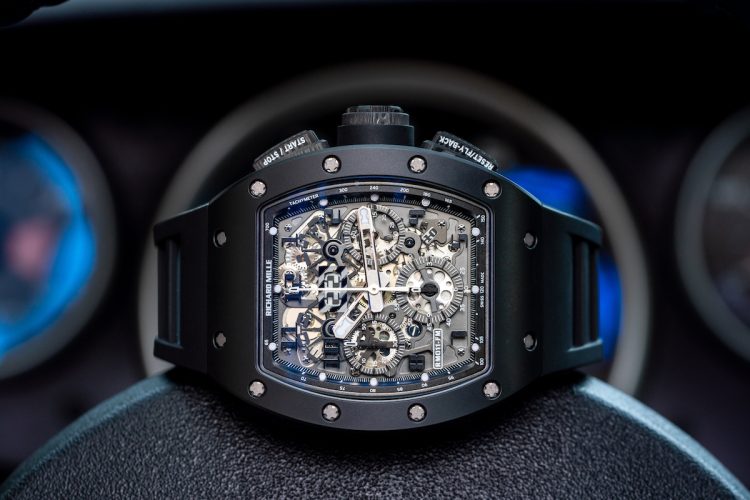Introduction
- Overview of Richard Mille Watches:
Richard Mille has established itself as a symbol of ultra-luxury, technological innovation, and cutting-edge design in the watch industry. These watches are not only known for their exclusive and avant-garde aesthetics but also for their remarkable technical complexity. Richard Mille’s unique materials and mechanical movements make the proper care and maintenance of these timepieces crucial for preserving their value, performance, and durability. - Why Maintenance Matters:
The craftsmanship that goes into each Richard Mille watch makes it an investment. However, with such advanced technology comes the need for regular upkeep. Whether it’s maintaining the intricate movement, cleaning the case, or ensuring the watch’s water resistance, proper care is essential to avoid any long-term damage that could reduce the watch’s value or performance. - What This Guide Covers:
This guide will delve into the essential aspects of maintaining a Richard Mille watch, including routine cleaning, movement care, material-specific upkeep, and the importance of servicing your timepiece through authorized channels.
Chapter 1: The Importance of Regular Maintenance
Why Richard Mille Watches Require Special Maintenance
- High-Tech Materials:
Richard Mille watches are known for their use of advanced materials like titanium, LITAL®-AL, ceramic, and sapphire crystal. These materials not only offer superior durability and lightness but also require specialized maintenance to keep their surface intact and prevent wear and tear. - Complicated Movements:
Richard Mille watches are also known for their complex mechanical movements. Each movement is built with fine tolerances, and maintenance is needed to preserve their precision, accuracy, and smooth operation. - Preserving Investment Value:
With prices starting in the tens of thousands and skyrocketing for limited edition models, maintaining the watch properly is important to retain its value. Well-maintained Richard Mille watches typically have a higher resale value.
Long-Term Benefits of Proper Maintenance
- Increased Longevity:
Regular servicing and upkeep can extend the life of the watch, ensuring that its precision and aesthetic appeal are preserved for generations. - Enhanced Functionality:
Consistent maintenance helps avoid issues with the watch’s movement and other features, ensuring it performs at its highest level. - Aesthetic Appeal:
Keeping the case, strap, and dial clean and free of damage will maintain the luxurious look and feel of the watch.
Chapter 2: Richard Mille Watch Components and Maintenance Overview
The Case and Bracelet: Protecting the Exterior
- Material Types and Their Care Needs:
- Titanium: Richard Mille’s use of titanium in the case and bracelet allows for a lightweight but durable watch. However, titanium is prone to scratching. Learn the best ways to clean and polish titanium without damaging it.
- LITAL®-AL Alloy: This aerospace-grade aluminum-lithium alloy is resistant to corrosion and damage. However, special care is needed to avoid scratches and abrasions that can affect its surface.
- Ceramic: Known for its scratch-resistant properties, ceramic requires different maintenance than metal. Learn how to clean and preserve ceramic cases and bracelets.
- Routine Cleaning of the Case and Bracelet:
- Tools You Need: The correct brushes, cleaning cloths, and specialized cleaning solutions.
- The Cleaning Process: Step-by-step instructions on how to clean each material type used in the Richard Mille case and bracelet.
- Polishing:
Occasionally, polishing the watch’s case and bracelet may be necessary to maintain its original shine. Discuss the risks of improper polishing and when professional servicing is required.
Chapter 3: The Movement: Caring for the Heart of Your Richard Mille
Overview of Richard Mille Movements
- Mechanical Movements:
Richard Mille predominantly uses mechanical (automatic and manual) movements in its timepieces. These watches require regular maintenance to ensure they continue to function optimally. - Complex Movements:
With features such as chronographs, tourbillons, and perpetual calendars, the movements inside Richard Mille watches can be intricate. Learn the specific care needed for these specialized movements.
Winding and Power Reserve Maintenance
- How Often Should You Wind the Watch?
Learn how often to wind your watch based on its power reserve and whether you should wind it daily or only when necessary. - Using a Watch Winder:
Watch winders can help maintain the power reserve without manual winding. Learn how to use them effectively to maintain your Richard Mille’s movement.
Lubrication and Movement Overhaul
- The Role of Lubrication in Movement Performance:
Lubrication reduces friction within the movement and prevents wear and tear. Understand how to tell when your watch needs a service, including the typical lubrication intervals for Richard Mille watches. - Movement Servicing:
Regular servicing by an authorized Richard Mille service center is essential for the movement’s long-term performance. Discuss the process of disassembling, cleaning, and reassembling the movement during a full service.

Chapter 4: Sapphire Crystal and Dial: Preserving the Watch Face
Sapphire Crystal Care
- Resilience of Sapphire Crystal:
Sapphire crystal is highly scratch-resistant but can still crack or shatter under extreme pressure or impact. Learn how to maintain the crystal’s clarity and avoid unnecessary damage. - Cleaning Sapphire Crystal:
A guide to cleaning sapphire crystal without scratching it. Learn what types of cleaning products to avoid and how to remove fingerprints, smudges, and dirt.
Dial and Hands Care
- Preventing Damage to the Dial:
The dial of a Richard Mille watch is delicate and can suffer from discoloration or damage if exposed to direct sunlight or chemicals. Tips on how to avoid long-term damage to the dial and hands. - Repainting and Repairing:
How to repair minor dial damage, including the possibility of repainting numerals or hands when necessary.
Chapter 5: The Strap: Maintaining Comfort and Aesthetics
Types of Straps and Their Care Needs
- Rubber Straps:
Richard Mille often uses rubber straps that are comfortable and flexible. However, they can become dirty and lose their elasticity over time. Learn how to clean rubber straps and how to protect them from UV rays. - Leather Straps:
For models that feature leather straps, learn how to care for leather to prevent cracking, discoloration, and wear. Discuss when it’s time to replace leather straps and how to select the right replacement. - Titanium and Other Metal Straps:
Care tips for metal straps, including cleaning, polishing, and adjusting.
Chapter 6: Servicing Your Richard Mille Watch
When to Service Your Watch
- Typical Service Intervals:
Learn how often to take your Richard Mille for professional servicing, including an overhaul of the movement and case. - Authorized Richard Mille Service Centers:
Why you should only use authorized service centers for repairs and maintenance. Discuss the potential risks of using unauthorized centers, such as voiding warranties and using non-genuine parts.
What Happens During a Full Service?
- Disassembly and Inspection:
A detailed breakdown of the steps involved in a complete service, including movement disassembly, cleaning, lubrication, and reassembly. - Parts Replacement:
Discuss the process of replacing worn or damaged parts, such as seals, gaskets, or internal components of the movement.
Chapter 7: Storing Your Richard Mille Watch
Proper Storage Practices
- Avoiding Extreme Conditions:
Discuss how to store your Richard Mille watch when you’re not wearing it. Avoiding exposure to extreme temperatures, humidity, or magnetic fields is crucial. - Using a Watch Winder:
For automatic watches, using a watch winder is essential to keep the movement ticking even when not in use. Learn how to select and use a watch winder properly.
Conclusion
- Summing Up the Key Maintenance Tips:
Reiterate the key steps that Richard Mille owners should take to ensure their watches remain in excellent condition for years to come. - Long-Term Care for Longevity:
Encourage readers to invest in proper care and regular servicing to protect the value and functionality of their timepieces. - Final Thoughts:
Richard Mille watches are much more than just timepieces—they are works of art and precision engineering. Caring for them properly ensures they continue to reflect the legacy of innovation and excellence that Richard Mille has built.





































